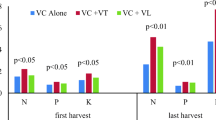Abstract
A greenhouse pot experiment was conducted to select vegetables for iodine uptake. The residual effect of iodate fertilization on the growth of and iodine uptake by spinach plants were also investigated. Six vegetables, including leafy vegetables (pakchoi [Brassica chinensis L.], spinach [Spinacia oleracea L.]), tuber vegetables (onion [Allium cepa L.]), shoot vegetables (water spinach [Ipomoea aquatica Forsk.], celery [Apium graveolens L.]), and root vegetables (carrot [Daucus carota var. sativa DC.]) were examined. Results showed that the concentrations of iodate in soil had significant effect on the biomass of edible parts of pakchoi and spinach (p<0.01), whereas the concentrations of iodate in soil had no significant effect on that of carrots, water spinach, celery, and onion. Iodine concentrations in edible parts of vegetables and the transfer factors (TFedible parts) of soil-to-edible parts of vegetables significantly increased with increasing iodine concentrations in soil (p<0.001), and iodine concentrations in edible parts and TFedible parts of spinach were much higher than those of other vegetables at any treatment. Both transfer coefficients for edible parts (TCedible parts) and for aerial parts (TCaerial parts) of vegetables changed differently with increasing iodine concentrations in the soil, and TCedible parts and TCaerial parts of spinach were higher than those of other vegetables. Therefore, spinach (leafy vegetable) was considered as an efficient vegetable for iodine biofortification. Further experiment showed that there is considerable residual effect of soil fertilization with iodate.
Similar content being viewed by others
References
X. L. Hou, C. F. Chai, Q. F. Qian, et al., The study of iodine in Chinese total diets, Sci. Total Environ. 193, 161–167 (1997).
Y. G. Zhu, Y. Z. Huang, Y. Hu, et al., Iodine uptake by spinach (Spinacia oleracea L.) plants grown in solution culture: effects of iodine species and solution concentrations, Environ. Int. 29, 33–37 (2003).
P. Jopke, M. Bahadir, J. Fleckenstein, et al., Iodine determination in plant materials, Commun. Soil Sci. Plant Anal. 27, 741–751 (1996).
X. Y. Cao, X. M. Jiang, A. Kareem, et al., Iodination of irrigation waters as a method of supplying iodine to a severely iodine-deficient population in Xinjiang, China. Lancet 344, 107–109 (1994).
X. M. Jiang, X. Y. Cao, J. Y. Jiang, et al., Four-year experience in iodination of irrigation water in Hotien, Xinjiang province of China, Arch. Environ. Health 152, 399–408 (1997).
R. A. Herrett, H. H. Hatfield, Jr., D. G. Crosby, et al., Leaf abscission induced by the iodine ion, Plant Physiol. 37, 358–363 (1962).
C. L. Mackowiak and P. R. Grossl, Iodate and iodide effects on iodine uptake and partitioning in rice (Oryza sativa L.) grown in solution culture, Plant Soil 212, 135–143 (1999).
T. Shinonaga, J. Casta, K. Muck, et al., Determination of iodine in cereal grains and standard reference materials by neutron activation analysis, Int. J. Environ. Anal. Chem. 78, 175–184 (2000).
R. K. Lu, The Analysis Method of Soil Agricultural Chemistry, China Agricultural Science and Technology Publishing, Beijing (2000) (in Chinese).
G. W. Borst and F. H. Pauwels, Iodine as a micronutrient for plants, Plant Soil 14, 665–671 (1961).
J. L. Dai, M. Zhang, and Y. G. Zhu, Adsorption and desorption of iodine by various Chinese soils: I Iodate, Environ. Int. 30, 525–530 (2004).
Z. T. Gong, The system classify of Chinese soil, Science Publishing, Beijing (1999) (in Chinese).
X. L. Hou, C. F. Chai, Q. F. Qian, et al., Determination of Br and I in biological and environmental materials with ENAA, Fresenius J. Anal. Chem. 357, 1106 (1997).
Author information
Authors and Affiliations
Rights and permissions
About this article
Cite this article
Dai, JL., Zhu, YG., Zhang, M. et al. Selecting iodine-enriched vegetables and the residual effect of iodate application to soil. Biol Trace Elem Res 101, 265–276 (2004). https://doi.org/10.1385/BTER:101:3:265
Received:
Accepted:
Issue Date:
DOI: https://doi.org/10.1385/BTER:101:3:265




